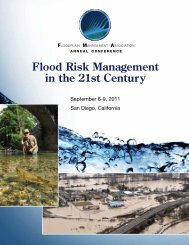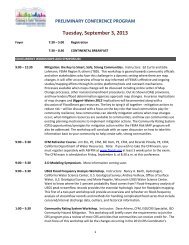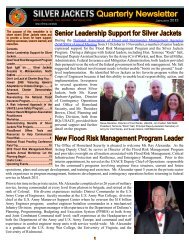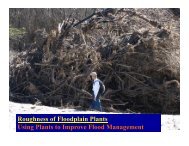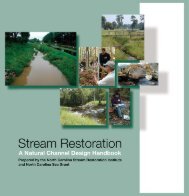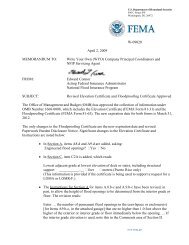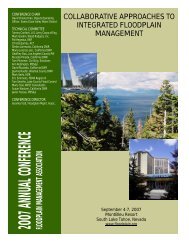Using Multi-Objective Management to Reduce Flood Losses in Your
Using Multi-Objective Management to Reduce Flood Losses in Your
Using Multi-Objective Management to Reduce Flood Losses in Your
You also want an ePaper? Increase the reach of your titles
YUMPU automatically turns print PDFs into web optimized ePapers that Google loves.
Habitat Evaluation Procedure: A method developed by the U.S. Fish and<br />
Wildlife Service that evaluates the suitability of wetlands and other habitat types<br />
for fish and wildlife species.<br />
HEP: Habitat Evaluation Procedure.<br />
HUD: U.S. Department of Hous<strong>in</strong>g and Urban Development.<br />
Human <strong>in</strong>tervention: A person must be present at the flood-prone site <strong>to</strong> close<br />
an open<strong>in</strong>g or <strong>in</strong>stall or operate a protection device so that the measure will<br />
prevent flood damage.<br />
Hydraulics: The science deal<strong>in</strong>g with the mechanical properties of liquids; it<br />
describes the pattern and rate of water movement.<br />
Hydrology: The science deal<strong>in</strong>g with the waters of the earth. A flood discharge<br />
is developed by a hydrologic study.<br />
Jetty: A structure built perpendicular <strong>to</strong> the shorel<strong>in</strong>e at <strong>in</strong>lets <strong>to</strong> prevent lit<strong>to</strong>ral<br />
drift from fill<strong>in</strong>g the <strong>in</strong>let and <strong>to</strong> provide protection for navigation.<br />
Lit<strong>to</strong>ral: Of or perta<strong>in</strong><strong>in</strong>g <strong>to</strong> the shore, especially of the sea.<br />
Lit<strong>to</strong>ral drift: The movement of sand by lit<strong>to</strong>ral (longshore) currents <strong>in</strong> a<br />
direction generally parallel <strong>to</strong> the beach along the shore.<br />
Mean high water: The average height of the maximum elevation reached by each<br />
ris<strong>in</strong>g tide over a specific 19-year period.<br />
Mean low water: The average height of the m<strong>in</strong>imum elevation reached by each<br />
fall<strong>in</strong>g tide over a specific 19-year period. All depth measurements <strong>in</strong> coastal<br />
waters and all depths shown on navigation charts are referenced <strong>to</strong> MLW.<br />
Mean sea level: The arithmetic mean of hourly heights observed over a specific<br />
19-year period.<br />
Mitigation: (1) Any action taken <strong>to</strong> permanently elim<strong>in</strong>ate or reduce the longterm<br />
risk <strong>to</strong> human life and property and the negative impacts on natural and<br />
cultural resources that can be caused by natural and technological hazards. (2) An<br />
action that compensates for the impact of development on a wetland.<br />
NAVD: North American Vertical Datum (see “datum”).<br />
NFIP: National <strong>Flood</strong> Insurance Program adm<strong>in</strong>istered by the Federal Emergency<br />
<strong>Management</strong> Agency’s Federal Insurance Adm<strong>in</strong>istration.<br />
NGVD: National Geodetic Vertical Datum of 1929, the national datum used by<br />
the National <strong>Flood</strong> Insurance Program. NGVD is based on mean sea level. It was<br />
known formerly as the “Mean Sea Level Datum of 1929 (MSL).”<br />
C-4





